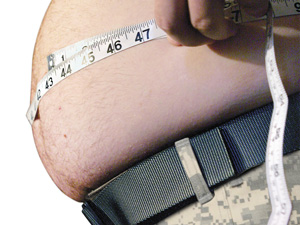March 16th, 2011 by RyanDuBosar in Better Health Network, Research
No Comments »

Obesity contributes to cardiovascular risk no matter where a person carries the weight, concluded researchers after looking at outcomes for nearly a quarter-million people worldwide.
Body mass index, (BMI) waist circumference, and waist-to-hip ratio do not predict cardiovascular disease risk any better when physicians recorded systolic blood pressure, history of diabetes and cholesterol levels, researchers reported in The Lancet.
The research group used individual records from 58 prospective studies with at least one year of follow up. In each study, participants were not selected on the basis of having previous vascular disease. Each study provided baseline for weight, height, and waist and hip circumference. Cause-specific mortality or vascular morbidity were recorded according to well defined criteria.
Individual records included 221,934 people in 17 countries. In people with BMI of 20 kg/m2 or higher, hazard ratios for cardiovascular disease were 1.23 (95 percent CI, 1.17 to 1.29) with BMI, 1.27 (95 percent CI, 1.20 to 1.33) with waist circumference, and 1.25 (95 percent CI, 1.19 to 1.31) with waist-to-hip ratio, after adjustment for age, sex, and smoking status. After adjusting for baseline systolic blood pressure, history of diabetes, and total and HDL cholesterol, corresponding hazard rations were 1.07 (95 percent CI, 1.03 to 1.11) with BMI, 1.10 (95 percent CI, 1.05 to 1.14) with waist circumference, and 1.12 (95 percent CI, 1.08 to 1.15) with waist-to-hip ratio.
BMI, waist circumference, or waist-to-hip ratio did not importantly improve risk discrimination or predicted 10-year risk, and the findings remained the same when adiposity — the carrying of adipose tissue (fat) — measures were considered. Read more »
*This blog post was originally published at ACP Internist*
February 4th, 2011 by AnnMacDonald in Better Health Network, Health Tips
No Comments »

When I was growing up, my parents had a simple rule when it came to food: “Finish everything on your plate.” We had to sit at the table until we did.
They meant well. They wanted us to understand that food should not go to waste. The problem with this advice — and I’m sure I’m not the only American who grew up with it — is that we learned early on to eat everything put in front of us when we sat down to meals. Then the size of the plates grew — and so did the amount of food we consumed.
 It’s called portion inflation. Take a look at the illustration at left. It’s based on an analysis published in the Journal of the American Dietetic Association which found that typical restaurant portion sizes today are two to eight times as large as those in 1955. Back then, people who consumed a typical American meal (a hamburger, French fries, and a soda) had only one portion size to pick from. Today we can choose from multiple portion sizes: reasonable, big, bigger, and ridiculous (as I’ve come to think of the sizes listed in that last column).
It’s called portion inflation. Take a look at the illustration at left. It’s based on an analysis published in the Journal of the American Dietetic Association which found that typical restaurant portion sizes today are two to eight times as large as those in 1955. Back then, people who consumed a typical American meal (a hamburger, French fries, and a soda) had only one portion size to pick from. Today we can choose from multiple portion sizes: reasonable, big, bigger, and ridiculous (as I’ve come to think of the sizes listed in that last column).
Portion size matters. The bigger the portion, the more calories you can consume. An example using a table of calorie information available online in the nutrition section at McDonald’s: By choosing the largest size in each category, you’ll end up consuming nearly triple the number of calories in a meal as you would if you chose the smallest portions.
| Food |
Smallest size/calories |
Largest size/calories |
| Hamburger |
3.5 oz/250 calories |
11.1 oz/750 calories |
| French fries |
2.5 oz/230 calories |
5.4 oz/500 calories |
| Coca Cola |
12 oz/110 calories |
32 oz/310 calories |
| Total calories |
590 calories |
1,560 calories |
Partly as a result of portion inflation, we’re eating more. Dietary surveys indicate that, on a per capita basis, Americans consumed 200 calories more per day in the 1990s than they did in the 1970s. That may not sound like a lot, but over time extra calories translate into extra pounds. Some experts calculate that people who add 150 calories a day to their diets, without increasing physical activity to burn those calories off, will gain as many as 15 pounds in a year. Read more »
*This blog post was originally published at Harvard Health Blog*
January 22nd, 2011 by Toni Brayer, M.D. in Health Tips, Research
2 Comments »

 Haven’t we all learned that breakfast should be our biggest meal? “Start the day with ‘fuel’ and you can burn it off as the day goes on.” “Eat a big breakfast and you’ll eat fewer calories all day long.”
Haven’t we all learned that breakfast should be our biggest meal? “Start the day with ‘fuel’ and you can burn it off as the day goes on.” “Eat a big breakfast and you’ll eat fewer calories all day long.”
This advice is probably not true, and in fact a new study published in the January 17th issue Nutrition Journal shows that people ate the same at lunch and dinner regardless of what they had at breakfast. If a person ate 1,000 calories at breakfast (which is easy to do with bacon, eggs, toast, hashbrowns, and juice), he or she had a total increase in calories eaten throughout the day by 1,000 calories.
This doesn’t mean we should be skipping breakfast. The problem may be what we historically think of as an “American” breakfast. It might have worked for the farmer in the past or the laborer hauling lumber, but it’s just too many calories for our current level of activity. Read more »
*This blog post was originally published at EverythingHealth*
January 2nd, 2011 by Glenn Laffel, M.D., Ph.D. in Better Health Network, News
No Comments »

 The FDA has been tough on diet drugs of late. Three years ago it scuttled an attempt to get the European diet drug rimonabant approved for use in the U.S. More recently it rejected, at least temporarily, applications for Qnexa and Lorcaserin.
The FDA has been tough on diet drugs of late. Three years ago it scuttled an attempt to get the European diet drug rimonabant approved for use in the U.S. More recently it rejected, at least temporarily, applications for Qnexa and Lorcaserin.
But that trend may have been reversed last week, when an advisory committee set the stage for possible FDA approval of Orexigen’s investigational diet drug, Contrave. By a 13-7 vote, the committee said in essence that the somewhat modest beneficial effects of the drug outweighed its tendency to increase blood pressure.
The FDA will make final decision on the matter by the end of January. It is not required to follow the advice of its advisory committees, but as was the case for the three diet drugs mentioned above, it usually does. Read more »
*This blog post was originally published at Pizaazz*
December 18th, 2010 by John Di Saia, M.D. in News
3 Comments »

 The Orange County Register blog posted on military plastic surgery and mentioned liposuction:
The Orange County Register blog posted on military plastic surgery and mentioned liposuction:
Army Times reports that soldiers are turning to liposuction to remove fat if extreme dieting, laxatives and other methods fail to get them under the Army’s weight limit for their height, age and gender.
“Liposuction saved my career. Laxatives and starvation before an [Army Physical Fitness Test] sustains my career,” a soldier told the periodical. “Soldiers are using liposuction, laxatives and starvation to meet height and weight standards. I did, do and still do.”
I am well aware of the military patient looking to stay within military parameters to stay in the service as my San Clemente office is quite close to Camp Pendleton, and I give military discounts. I have seen several of these patients in my decade in San Clemente. Surgery for wives still outnumbers surgery for soldiers, though.
As some of these clients have explained, the Marine administration requires active duty soldiers to have certain measurements at a certain weight. Those who do not fall within these expected norms are first warned and then penalized. Liposuction has worked at times to keep some of these soldiers in the service.
– John Di Saia, M.D.
*This blog post was originally published at Truth in Cosmetic Surgery*




















